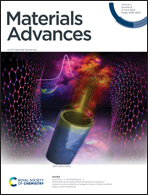Design and development of a new flowable and photocurable lactide and caprolactone-based polymer for bone repair and augmentation†
Abstract
With a global aging population, there is a high demand for new biomaterials that provide regenerative or fixation modalities following a bone injury. Here, the design and development of newly synthesised poly(L-lactic acid)-dimethacrylate (PLLA-DM) and poly(caprolactone-co-fumarate)-dimethacrylate (PCF-DM) monomer systems serves to address some of the main medical challenges and requirements of surgeons during application and better postoperative outcomes of new bone-healing biomaterials. Synthesis of PLLA-DM and PCF-DM via ring opening polymerisation (ROP) and polycondensation routes led to low MW ‘flowable’ and resorbable monomers that polymerise in-situ at up to 6 mm curing depth. Tensile testing of photocured PLLA-DM/PCF-DM formulations at strain rate 0.05 s−1, revealed elastic moduli of 4.4 ± 0.5 to 11.7 ± 2.5 (SD) GPa, with ultimate tensile strength ranging between 29.7 ± 4.9 to 76.1 ± 13.5 (SD) MPa. Resazurin-based metabolic activity studies via an indirect contact method involving Saos-2 osteoblast-like cell lines revealed enhanced cytocompatibility with metabolic activity of treated Saos-2 cells increasing by up to 20% compared with respective untreated control groups. Attachment of Saos-2 cells on PLLA-DM/PCF-DM specimen surfaces revealed cellular structures such as filopodia extending beyond lamellipodia, indicative of remarkable cell adhesion and favouring colonization. The initial development of the polymer chemistry presented here provides the potential for the design and further development towards a new resorbable biomaterial with enhanced mechanical properties for bone repair and augmentation involving both orthopaedic (bone cement) and restorative dentistry applications.



 Please wait while we load your content...
Please wait while we load your content...